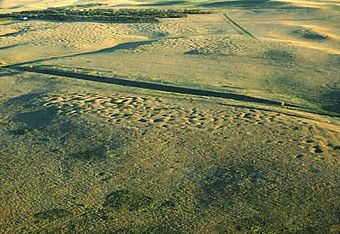Lynch Quarry Site facts for kids
|
Lynch Quarry Site
|
|

Aerial view of the site (National Park Service photo)
|
|
| Lua error in Module:Location_map at line 420: attempt to index field 'wikibase' (a nil value). | |
| Nearest city | Dunn Center |
|---|---|
| Area | 690 acres (280 ha) |
| NRHP reference No. | 11000629 |
Quick facts for kids Significant dates |
|
| Added to NRHP | July 13, 2011 |
| Designated NHL | July 13, 2011 |
The Lynch Quarry Site is a very old place near Dunn Center, North Dakota. It is also known as the Lynch Knife River Flint Quarry. This site was a huge source of flint, a special type of rock. People long ago used this flint to make tools.
Archaeologists believe people mined flint here for a very long time. This was from about 11,000 B.C. to A.D. 1600. That's over 12,000 years of history! In 2011, the site became a National Historic Landmark. This means it's a very important place in American history.
Contents
What is the Lynch Quarry Site?
The Lynch Quarry Site is a large area where ancient people dug for flint. It covers about 690 acres (279 hectares). This is like having over 500 football fields filled with history! The site has an estimated 20,000 pits. These are holes where people dug out the flint.
The pits are usually 3 to 10 feet (1 to 3 meters) deep. Next to these pits, you can see piles of leftover rock. These are called spoil piles. The site is located near Spring Creek. This creek flows into the Knife River.
Why Was Knife River Flint Special?
Knife River Flint was a very popular material for making tools. It was easy to shape into sharp objects. People used it to make projectile points (like arrowheads), knives, and scraping tools. Imagine using a rock to make a tool that could cut!
This special flint was highly valued by ancient people. It was traded far and wide across North America.
Where Was the Flint Found?
Flint from the Knife River quarries has been found in many places. It traveled to northern Canada, New York, and New Mexico. This shows how important trade was long ago. People traded flint for other valuable items. These included shells, obsidian (another type of rock), cloth, and even metal weapons later on.
Discovering Ancient Tools
The Lynch site is very well preserved. This means it still looks much like it did thousands of years ago. Even though some farming has happened there, and some coal mining shafts were dug, the site remains mostly untouched.
When experts looked at the site, they found it covered in chipped and flaked stone. This shows how much work happened there. It's like a giant outdoor workshop from ancient times. Studying this site helps us learn about the lives of early North Americans.

